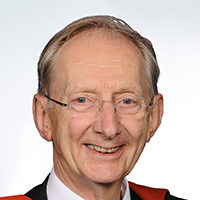
John Pendry
2024 Kyoto Prize Laureates
Materials Science and Engineering
/ Theoretical Physicist
1943 -
Professor of Theoretical Solid State Physics, Imperial College London
2024
11 /11 Mon
13:00 - 16:10
Place:Kyoto International Conference Center
Capacity:1,500 persons (FCFS)
Admission Free
John Pendry theoretically demonstrated that materials with electromagnetic properties not found in nature, such as negative-refractive-index materials (metamaterials) can be realized by designing microstructures smaller than the wavelength of the target electromagnetic waves, thereby laying the groundwork for creating innovative materials such as “superlenses” with subwavelength resolution and “invisibility cloaks.”
It is difficult to artificially control and tailor the electromagnetic properties of materials as they are usually determined by the electronic structures of the materials, which in turn result from the atomic compositions and crystal structures of the materials. However, John Pendry theoretically demonstrated that if electrically conductive structures that are significantly smaller than the wavelengths of the relevant electromagnetic waves are ingeniously designed and utilized, one can create a new class of materials (metamaterials); these materials exhibit properties not found in nature, such as a negative refractive index. Specifically, he elucidated that materials with a negative permeability can be realized by employing small split-ring structures of non-magnetic conductors that exhibit resonant states in response to electromagnetic waves (1). He further demonstrated that both negative permittivity and negative permeability can be simultaneously realized in materials comprising non-magnetic conductive arrays of both wire and split-ring structures (2). Although the concept of materials with both negative permittivity and permeability was discussed in the 1960s and the materials were predicted to yield a negative refractive index, it was Pendry who established the theoretical framework for the design and realization of such materials. Shortly thereafter, based on his theory, metamaterials exhibiting a negative refractive index were experimentally demonstrated for the first time.
The fundamental concept underlying Pendry’s metamaterials is that novel electromagnetic properties can be realized by employing ingeniously designed electrically conductive structures of scales that are significantly smaller than the wavelengths of relevant electromagnetic waves. This idea has opened new possibilities for tailoring various electromagnetic phenomena. For instance, materials with a negative refractive index exhibit a unique phenomenon: refracted waves generated at the material interface propagate along a direction opposite to that of the incident waves. As an example of leveraging such unique properties of negative refractive metamaterials, Pendry proposed the concept of a “superlens” (perfect lens), which can achieve infinite spatial resolution beyond the usual diffraction limit, and demonstrated its effectiveness in a microwave regime (2). Research and development of devices based on this concept are underway globally.
Furthermore, Pendry proposed the concept of “transformation optics,” which involves the coordinate transformation of Maxwell’s equations to manipulate the paths of electric and magnetic fields as well as the energy flows of electromagnetic waves (3). This concept has expanded the design flexibility of optical components and has been used in the design of various metamaterial devices. Notably, his well-known proposal of an “invisibility cloak” utilizes a unique possibility of controlling electromagnetic waves with metamaterials to reroute light and/or microwaves around a shielded area and force them to their original paths, effectively rendering the area invisible. This concept has attracted wide attention from both the academic community and general public. By working with an experimental research group, Pendry successfully demonstrated this novel possibility at microwave frequencies (4).
Thanks to Pendry’s pioneering works, metamaterials research has enormously advanced worldwide since the early 2000s and a wide range of applications have become possible, encompassing microwave control, heat shielding, and light wave technologies. Pendry’s innovative theoretical research on metamaterials has substantially expanded the field of materials science, created new interdisciplinary research areas, and paved the way for the widespread social applications of novel materials. His achievements are highly esteemed.
For these reasons, the Inamori Foundation is pleased to present the 2024 Kyoto Prize in Advanced Technology to John Pendry.
References
(1) Pendry JB et al. (1999) Magnetism from Conductors and Enhanced Nonlinear Phenomena. IEEE Trans. Microw. Theory Tech. 47 (11): 2075–2084.
(2) Pendry JB (2000) Negative Refraction Makes a Perfect Lens. Phys. Rev. Lett. 85 (18): 3966–3969.
(3) Pendry JB, Schurig D, & Smith DR (2006) Controlling Electromagnetic Fields. Science 312: 1780–1782.
(4) Schurig D et al. (2006) Metamaterial Electromagnetic Cloak at Microwave Frequencies. Science 314: 977–980.
Profile is at the time of the award.